Many new contact lens wearers, and even some experienced ones, have difficulty knowing how to tell if contact lenses are inside out. It is important to know how to do this because an inverted contact lens that goes onto the eye will not be comfortable, will not provide clear vision, and will risk falling out of the eye and getting lost.
There are several methods to determine whether a lens is inside out or not, and in this post I will explain my 5 favorite techniques.
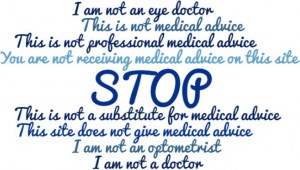
I am not a doctor and this article is not a substitute for professional medical advice. Please read Contacts Advice Terms of Use before continuing.
Technique #1: Edge Shape
The first technique is the place the lens on the tip of your finger, hold it up at eye level, and observe the edges of the contact lenses. There will be a subtle difference in the way the edges look for a contact lens that correct, and one that is inverted. It will be easier to demonstrate this with pictures, rather than trying to explain it words, but when the lens in the correct orientation, the edges of the contacts curve straight upwards, like a bowl shape. When the contact lens is inverted, the edges will tend to flare outwards, like a saucer shape. Still doesn’t make sense? Don’t worry, just keep reading.
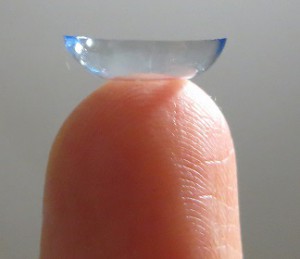
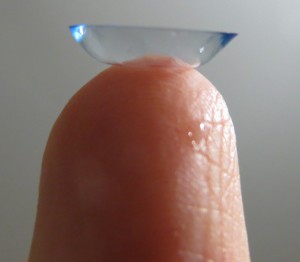
Observe the edges of these contact lenses and see if you can tell the difference. If you still can’t, look at these up close pictures:
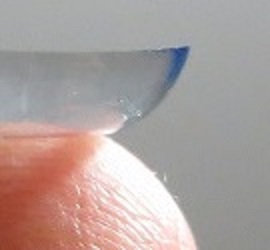
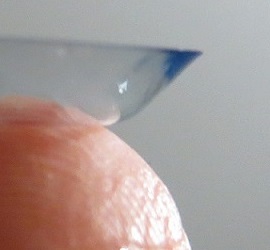
Pretty neat, isn’t it? If you find this difference too subtle, then read on, there are plenty other tricks!
Technique #2: The Taco Test
The second technique can be done immediately following the first technique in order to reaffirm your suspicions. Again, with the contact lens placed on the tip of your finger, use the index finger and thumb of your other hand to push two opposing edges of the contact lens together, as though you were trying to close it.
As you push the two halves towards each other, if the edges come together and the contact lens starts to take a hard shelled taco shape, this means the lens is in the correct orientation.
Alternatively, if as you do this, the edges of the lens move away from each other, and seem to want to stick to your finger and thumb, this means the lens is inside out.
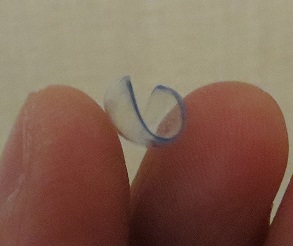

Technique #3: The Easy Flip Test
The extent to which this technique will be effective may depend on the specific brand of contact lenses you’re using. But in general, a contact lens will be more difficult to flip when it is in the correct orientation, and vice versa, it will flip more easily when it is in the inverted position.
If you are unsure about how to use use the first two techniques, flip your contact lens in and out a few times. If it is difficult to flip, you’ve most likely just made it inside out. If it flips almost without any effort, you’ve most likely just flipped it into the correct position.
If you’ve just used this technique to figure out which way is correct, I would recommend rinsing the contact lens off with cleaning solution before you go ahead and insert, because will have certainly been touching the inside of the contact lens with your fingers by doing this.
Technique #4: Keep the Original Orientation
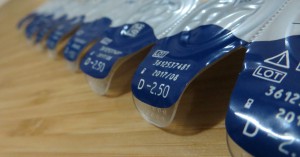 This technique applies mostly to daily lenses, but can also be used for bi-weekly and monthly lenses. This technique replaces the need to check for ‘inverted-ness’ using the above techniques by simply paying attention to the way the contacts are inside the packaging.
This technique applies mostly to daily lenses, but can also be used for bi-weekly and monthly lenses. This technique replaces the need to check for ‘inverted-ness’ using the above techniques by simply paying attention to the way the contacts are inside the packaging.
When the contact lenses are made, they are placed into their packaging in the correct way. It is very rare for the contact lenses to flip on their own within the sealed blister packs, therefore, when you open the little pack that contains your lens, you can safely assume that it’s already in the correct position.
So by simply making sure you don’t flip the lens as you remove it from the blister pack, you know it will not be inverted.
Technique #5: The Last Resort
The final technique is to just put the contact lens in your eye. If it is correct, it will feel comfortable within seconds, your vision should be clear, and blinking should not cause the lens to move about wildly on your eye. If this is the case, great! You’re free to go about your day. If it was inside out however, you will feel it! It will not become comfortable, your vision will be off, and every time you blink you will feel the contact lens moving around all over the place. That’s when you know to take it out, flip it, and re-insert it. Obviously, this is the last technique you want to have to resort to, but having an inverted contact lens on for a few seconds, though it may be uncomfortable, will not harm your eye.
Over time as you become more familiar with how contact lenses feel, you will begin to develop an instinct for it and not have to go through these steps every time. You will eventually be able to insert and remove your contact lenses with your eyes closed (figuratively speaking, of course)! Be patient with yourself at first and give yourself enough time to insert your contact lenses before you go off to school, work. etc. This will take the stress and frustration off of racing against the clock to get them in!
I hope you found this information helpful. If you have any questions, or if you have any of your own helpful tips or tricks regarding this subject, I would love to hear them! Please share them in the comments section below.




12 Responses
Angela
Great tips for how to tell if contact lenses are inside out. Thanks for sharing pictures that way seeing it visual really helps to know what to look for. Great article and thanks for sharing!!
Julie
Hi Angela!
It’s my pleasure. Thanks for the comment :)
Emily
hi Julie
as a long time contact lenses wearer, where was this post the million times I put my contacts inside out??? lol I literally did that so many times with the blinking that ensued and the flipping the contact back and forth until your eye is so irritated you don’t know which side is which! Very good advice here Julie, thanks a lot for this!
Julie
Hi Emily!
Oh I know, I went through the same thing too when I started wearing contacts at age 15. And I was never taught these trick back then! I also never imagined that I’d be teaching this stuff now lol. Thanks for reading!
Dee
Julie, this is such a great post! This was my initial struggle when I first got my contacts and years later, there are days when I’m still unsure whether my contacts are inside-out or not. I only knew about the first technique but when your glasses are off, determining the edge shape gets a little more difficult. :P I’m so glad I’ll have these techniques and visuals to help me out in the future. You’re the best!
Julie
Hi Dee!
I hope that now you’ll never be unsure again :) Thanks for reading!
ann
so looking down topside at the contact, when I see the outer rim with a lip flared out, it is inverted ?
but correct it is up like a bowl no outer lip ?
Julie
Yes! I personally find the the effect is easier to see when you look at them from the side. But as long as you can see it, that’s all that matters!
Andy Paradise
Great tips! Thank you. I was only taught the flared edge trick. I’m a newby and have only been wearing multifocals for a month. I hope to avoid inverted lenses in the future. Thank you for the write up. Cheers, Andy.
Julie
Hi Andy, I’m glad you found my tricks helpful! Most people are only taught to look at the edge to determine if a contact lens in inside out, but for beginners it’s difficult to know what looks normal and what doesn’t. My favorite trick is the Taco Test. Good luck with your multifocals!
Steve Dorsett
Thank you for the easy to follow instructions on determining if you lenses is correct or not. Do you have any ideas of why my vision gets blurry while wearing my contacts. They clear and everything is great but only about 10% of the time, otherwise my vision is blurry and I have to strain to see anything. Any help is appreciated. I recently changed from glasses to contacts for convenience. My vision is more consistent without the lenses.
Thank you in advance
Julie
Hi Steve,
This issue could be many different things. Off the top of my head, I would say the most common problems with inconsistent vision in contact lenses is an improper prescriptions, specifically when it comes to fluctuating vision, an improper Axis. This could only be the cause if you were contact lenses for astigmatism. If you don’t, it could be that your contact lenses are too strong, and sometimes your eyes can focus through it giving you clear vision, but if your focusing muscles give up trying your vision will become blurry. These are just a couple of guesses of course. I’m not an eye doctor and I don’t know any details about your prescription. So take everything written here with a grain of salt!
Needless to say, this is not to be considered as medical advice.